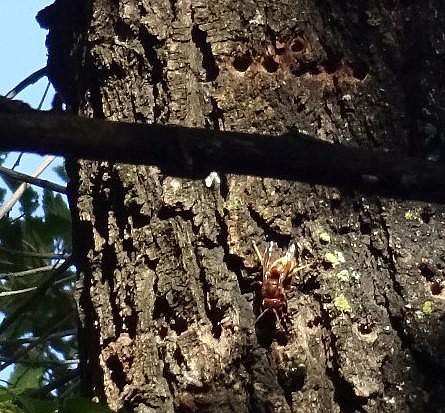Q. These hornets, which might be European hornets, are active around this elm tree, and I see these holes on the tree (see photo). Did they make them? What can I do to get rid of them?
A. Good ID! I checked with an entomologist on campus just to confirm; they are European hornets, pretty big insects at about 1 inches. There is a good publication from University of Kentucky Extension Entomology about them. It says, "When food becomes scarce in the fall, they will search for sweets. Some will girdle twigs and branches of lilac, birch, and other species and collect the sap that bleeds from the wounds. Others may chew holes in tree fruit for liquids."
The hole size and pattern is consistent with that caused by the migratory bird yellow belly sapsucker, which creates the holes to feed on exuding sap. So it is probable the hornets are taking advantage of that. The Kentucky publication goes on to say, "It is difficult to prevent this from happening because the location of their colony may be impossible to find." I would first make sure they didn't build a nest in your attic. Secondly, every year I seem to get a call on a warm fall evening preceding a cold front with something "off" like this. There's a good chance they may stop being so active with the cooler weather. However, if they return, try treating the trunks with a liquid Sevin spray when they aren't around (early morning when cooler and before it gets sunny). Make sure to get some spray into the holes. Keep your eye out for any dead or dying hornets, and keep the kids away.
Q. I have an area next to my vegetable garden that I'd like to turn into wildflowers. Is it cheaper to establish a wildflower planting by seed? Can it be done now?
A. It should be less expensive to start from seed, especially if the location is lager. If it is an area where a half-dozen or so perennial plants will grow, then buying plants may be easier and only a bit more expensive. But for larger areas seed is probably a better option, especially if the ground can be clean tilled. There are seed mixes that can be planted in the fall, so it might be ideal now given you can work up the soil. We have a very well regarded company in this area just south of Jefferson City.
Missouri Wildflower Nursery sells both plants and many types of seeds and seed mixes. Give them a call at 573-496-3003. Missouri Prairie Foundation's Grow Native program is a great option for publications and other resources: grownative.org.
Q. I'd like to move a couple of small deciduous trees this fall. Can I do it now?
A. It depends upon the tree. We'd like to see the tree leaves changing color or falling off. That means the tree is rapidly going dormant or dormant. Many trees are doing such now or already have. However, many oaks hang onto their leaves for another month. It can be stressful to a tree to be uprooted while still full of green leaves. Because the tree knows the days are shortening, it might just drop the leaves, but if not, this can damage the tree.
Many of the tree roots will be lost, so it is a good idea to trim back the tree by about one-third. This reduce the amount of leaves next spring, giving the roots a chance to catch up with their growth. Having the tree in its new location through the winter will also allow some root growth to occur. If you have questions about soil preparation, fertilizer, etc., please contact us.
Q. I have heard about a fall festival being held across the river in a garden. Where and when is it?
A. The River City Fall Festival is a free all-day event on Oct. 22. There will be handmade craft and food booths, live entertainment, pony rides, clowns, petting zoo, wagon rides, pumpkins and other activities for the entire family. It is hosted by the Central Missouri Master Gardeners in cooperation with the Jefferson City Parks and Recreation and Fischer Farms.
This event is held at the River City Gardens, which are in North Jefferson City, just -mile west over the overpass at the airport exit. These gardens received their official name this summer and are adjacent to the Bill Quigg Commons, making a nice public/private partnership area with Jefferson City Parks and Recreation. The gardens have been there for more than a decade but have recently been expanded and present ornamental and vegetable plantings, garden art, a pavilion and turf plots.
The Central Missouri Master Gardeners are a volunteer group of 191 members, 122 of whom are Cole County residents, who maintain 11 beautification sites in Cole County, which are nonprofits or public entities. Master Gardeners must complete a basic training program of at least 30 hours of horticultural training, as well as 30 hours of volunteer service. The Missouri Master Gardener program is supported by the University of Missouri Extension.
Have a gardening question of your own? Call 573-634-2824 or stop by the Cole County Extension Center in Jefferson City at 2436 Tanner Bridge Road.

